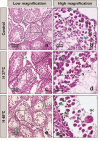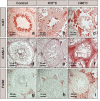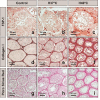Chronic scrotal heat stress causes testicular interstitial inflammation and fibrosis: An experimental study in mice
- PMID: 36187742
- PMCID: PMC9446441
- DOI: 10.18502/ijrm.v20i7.11559
Chronic scrotal heat stress causes testicular interstitial inflammation and fibrosis: An experimental study in mice
Abstract
Background: Chronic heat stress is a risk factor that adversely affects the reproduction system. Inflammation and fibrosis are 2 important response processes to damaged tissues.
Objective: This study investigates the association of chronic scrotal heat stress with testicular interstitial inflammation and fibrosis in mice.
Materials and methods: For all experiments, 8-10 wk old male Swiss mice (Mus musculus) (20-23 gr) were divided into 3 groups (n = 10/each). The heat-stress groups were submerged in a water bath at 37 C and 40 C, while the control group was treated at 25 C. The testicular tissues underwent hematoxylin and eosin staining, picro sirius red staining, and immunohistochemistry for intercellular adhesion molecule-1, fibroblast-specific protein 1, F4/80, collagen I, and Ki-67 staining to determine the testicular interstitial inflammation and fibrosis.
Results: Chronic scrotal heat stress impairs spermatogenesis and reverses testicular histological structure. In this study, heat stress significantly induced increased interstitial cell proliferation and upregulation of intercellular adhesion molecule-1 expression in the interstitial testicular tissue. In the interstitial testicular tissue, the number of F4/80-positive macrophages and the number of fibroblast-specific protein 1-positive fibroblasts were significantly increased in the heat-exposed groups compared to those in the control group. The heat exposed groups had substantially increased extracellular matrix collagen accumulation in their testicular interstitial tissues.
Conclusion: Heat stress adversely affects the testicular structure and spermatogenesis, causes inflammation, and leads to testicular interstitial fibrosis.
Keywords: Fibrosis.; Inflammation; Testicular; Heat stress.
Copyright © 2022 Nguyen-Thanh et al.
Conflict of interest statement
The authors declare that there is no conflict of interest.
Figures






Similar articles
-
Heat stress decreases testicular germ cell proliferation and increases apoptosis in short term: an immunohistochemical and ultrastructural study.Toxicol Ind Health. 2013 Mar;29(2):99-113. doi: 10.1177/0748233711425082. Epub 2011 Nov 14. Toxicol Ind Health. 2013. PMID: 22082826
-
Fibroblast-specific plasminogen activator inhibitor-1 depletion ameliorates renal interstitial fibrosis after unilateral ureteral obstruction.Nephrol Dial Transplant. 2019 Dec 1;34(12):2042-2050. doi: 10.1093/ndt/gfz050. Nephrol Dial Transplant. 2019. PMID: 31071225 Free PMC article.
-
Investigation of activin A in inflammatory responses of the testis and its role in the development of testicular fibrosis.Hum Reprod. 2019 Aug 1;34(8):1536-1550. doi: 10.1093/humrep/dez109. Hum Reprod. 2019. PMID: 31340036
-
Review: Testicular vascular cone development and its association with scrotal thermoregulation, semen quality and sperm production in bulls.Animal. 2018 Jun;12(s1):s133-s141. doi: 10.1017/S1751731118001167. Animal. 2018. PMID: 29882506 Review.
-
Amelioration of heat stress-induced damage to testes and sperm quality.Theriogenology. 2020 Dec;158:84-96. doi: 10.1016/j.theriogenology.2020.08.034. Epub 2020 Sep 8. Theriogenology. 2020. PMID: 32947064 Review.
Cited by
-
The Impact of High-Temperature Stress on Gut Microbiota and Reproduction in Siberian Hamsters (Phodopus sungorus).Microorganisms. 2024 Jul 13;12(7):1426. doi: 10.3390/microorganisms12071426. Microorganisms. 2024. PMID: 39065194 Free PMC article.
-
Risk Factors for Testicular Cancer: Environment, Genes and Infections-Is It All?Medicina (Kaunas). 2023 Apr 7;59(4):724. doi: 10.3390/medicina59040724. Medicina (Kaunas). 2023. PMID: 37109682 Free PMC article. Review.
-
A Review of the Effects of Some Extrinsic Factors on Mice Used in Research.Comp Med. 2023 Dec 1;73(6):413-431. doi: 10.30802/AALAS-CM-23-000028. Comp Med. 2023. PMID: 38217072 Free PMC article. Review.
References
-
- Rockett JC, Mapp FL, Garges JB, Luft JC, Mori C, Dix DJ. Effects of hyperthermia on spermatogenesis, apoptosis, gene expression, and fertility in adult male mice. Biol Reprod. 2001;65:229–239. - PubMed
-
- Boni R. Heat stress, a serious threat to reproductive function in animals and humans. Mol Reprod Dev. 2019;86:1307–1323. - PubMed
-
- Cammack KM, Antoniou E, Hearne L, Lamberson WR. Testicular gene expression in male mice divergent for fertility after heat stress. Theriogenology. 2009;71:651–661. - PubMed
-
- Durairajanayagam D, Agarwal A, Ong Ch. Causes, effects and molecular mechanisms of testicular heat stress. Reprod Biomed Online. 2015;30:14–27. - PubMed
LinkOut - more resources
Full Text Sources
Research Materials
